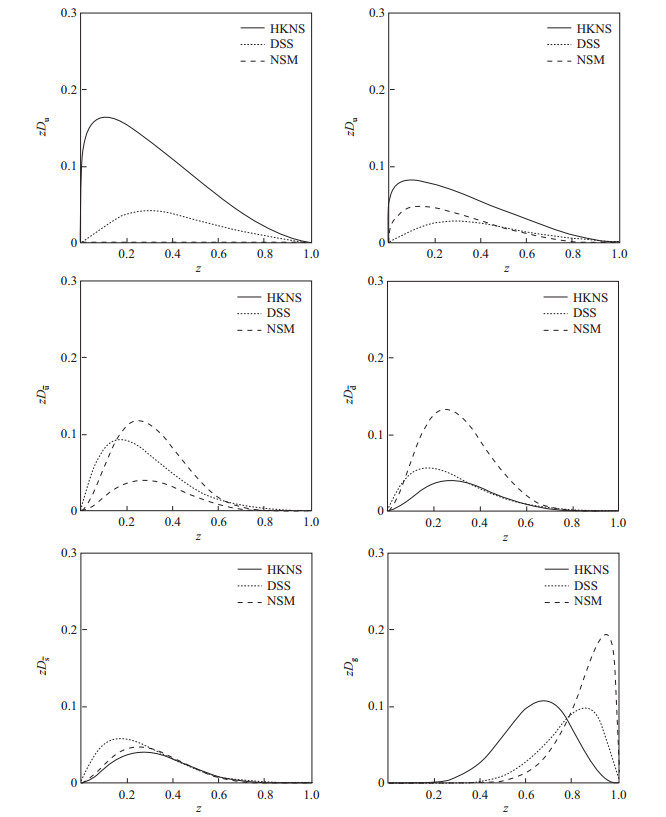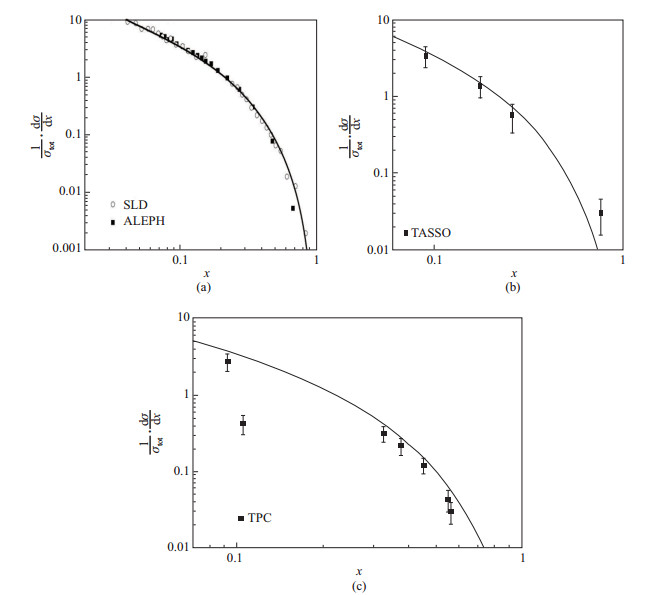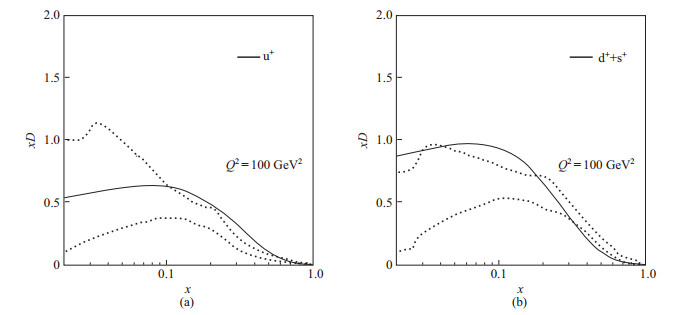部分子分布函数和碎裂函数是分析高能碰撞过程的两个重要的物理量.部分子分布函数
本文用
部分子分布函数和碎裂函数都是非微扰的物理量, 目前不能通过理论方法计算得到, 不同的研究小组都是通过大量拟合实验数据来推断出分布函数和碎裂函数的.现在已经有多个研究小组给出了质子的分布函数, 且被广泛应用, 例如GJR08[4]、ZRS[5]、MSTW08[6]和CTEQ[7]等.每个小组都拟合出在某一动量标度
本文是这样安排的:第1节对DSS、HKNS和NSM这几个研究小组的质子的碎裂函数进行详细的比较和讨论, 由于这几个研究小组的差别很大, 需要从理论上给予进一步的限制; 第2节分析朴素部分子模型下质子分布函数和碎裂函数的关系, 找到一个简单的联系价夸克分布函数和碎裂函数的关系式, 并建立一组新的碎裂函数的表示形式; 第3节, 通过与实验数据的比较, 分析本文新参数式的合理性, 并对结果进行讨论.
1 几组部分子碎裂函数的分析和比较部分子碎裂函数是通过正负电子湮灭并碎裂为强子或其他强子产生过程的实验数据进行分析拟合得到的.基本的做法是:先选定一个初始标度
| $ \begin{equation} \sum\limits_h {\int_0^1 {zD_i^h } } (z, Q^2){\rm d}z=1, \end{equation} $ | (1) |
即某一部分子最后碎裂成的所有强子的动量总和应该和这个部分子的相等.式(1)中的求和是对所有末态产生的强子求和, 这是对碎裂函数的一个约束条件.但由于实验不可能记录下末态产生的所有强子, 所以实际求和后的结果应该小于1, 这又给确定碎裂函数带来了不确定性.并且, 一个部分子碎裂成的所有不同类型的强子中, 每一种所占的动量比例实验也不确定.这一系列的因素影响了人们对碎裂函数的判断, 它的困难远远大于对部分子分布函数的确定.
目前, 对部分子碎裂为质子的碎裂函数应用比较普遍的是DSS、HKNS和NSM研究小组, 他们都是取
| $ \begin{align} \left\{\!\! \begin{array}{l} D_{\rm u} =z^{0.041}(1+15(1-z)^{3.44})(0.20714(1-z)^{1.485}-0.193173(1-z)^{1.988}), \\[1mm] D_{\rm d} =z^{0.041}(1+15(1-z)^{3.44})(0.13002(1-z)^{1.485}-0.11805(1-z)^{1.988}), \\[1mm] D_{\overline{\rm u}} ={0.09659}z^{0.041}(1-z)^{1.998}[1+15.0(1-z)^{3.44}], \\[1mm] D_{\overline{\rm d}} ={0.05903}z^{0.041}(1-z)^{1.998}[1+15.0(1-z)^{3.44}], \\[1mm] D_{\rm s} =D_{\overline{\rm s}} =0.{06037}z^{0.041}(1-z)^{1.998}[1+15.0(1-z)^{3.44}], \\[1mm] D_{\rm c} =D_{\overline{\rm c}} =0.33473z^{-0.887}(1-z)^{5.436}, \\[1mm] D_{\rm b} ={3.84107}z^{{0.103}}(1-z)^{{10.0}}, \\[1mm] D_{\rm g} ={2.97933}z^{6.0}(1-z)^{1.{2}}, \end{array} \right. \end{align} $ | (2) |
其中
HKNS给出的参数式形式稍微简洁一些, 为
| $ \begin{align} \left\{\!\! \begin{array}{l} D_{\rm u} =2D_{\rm d} ={0.29747}z^{-0.814}(1-z)^{1.628}, \\[1mm] D_{\overline{\rm u}} =D_{\overline{\rm d}} =D_{\rm s} D_{\overline{\rm s}} ={2.32320}z^{0.866}(1-z)^{5.078}, \\[1mm] D_{\rm c} =D_{\overline{\rm c}} ={6.07301}z^{0.683}(1-z)^{7.375}, \\[1mm] D_{\rm b} =D_{\overline{\rm b}} ={2.19402}z^{0.071}(1-z)^{8.802}, \\[1mm] D_{\rm g} ={30.50742}z^{5.0}(1-z)^{2.927}, \end{array} \right. \end{align} $ | (3) |
且取所有u、d、s海夸克的碎裂函数为相同的分布.
NSM的碎裂函数的参数式形式为
| $ \begin{align} \left\{\!\! \begin{array}{l} D_{\rm u} ={0.028}z^{-1.547}(1-z)^{2.710}(1-e^{-0.052z}), \\[1mm] D_{\rm d} =3.382z^{-1.547}(1-z)^{2.710}(1-e^{-0.052z}), \\[1mm] D_{\overline{\rm u}} =7.634z^{-0.053}(1-z)^{5.389}(1-e^{-1.269z}), \\[1mm] D_{\overline{\rm d}} =8.592z^{-0.053}(1-z)^{5.389}(1-e^{-1.269z}), \\[1mm] D_{\rm s} =D_{\overline{\rm s}} =3.110z^{-0.053}(1-z)^{5.389}(1-e^{-1.269z}), \\[1mm] D_{\rm c} =D_{\overline{\rm c}} =4.829z^{{0.733}}(1-z)^{7.046}, \\[1mm] D_{\rm b} =D_{\overline{\rm b}} =10.031z^{0.681}(1-z)^{11.466}, \\[1mm] D_{\rm g} =1.237z^{6.915}(1-z)^{0.482}. \end{array} \right. \end{align} $ | (4) |
可以看出, 3组参数中, 对c、b夸克和胶子, 研究小组所取的参数形式都相同, 但参数取值完全不一样; 对价夸克和u、d、s海夸克, 研究小组采用了不同的参数式形式.
本文比较了DSS、HKNS和NSM在初始标度

|
图 1 标度 |
研究小组间差别的另一个重要来源, 是对公式(1)的运用.本文计算了
|
表 1 动量标度 |
最早描述部分子分布函数和碎裂函数之间联系的是所谓的DLY(Drell-Levy-Yan)关联[12-14], 即
| $\begin{equation} \dfrac{1}{z}D(z)=q\Big(\dfrac{1}{z}\Big). \end{equation} $ | (5) |
利用深度非弹性散射和正负电子湮灭过程中强子张量的定义可以对这个联系进行详细的证明. DLY关联指出了碎裂函数可以通过分布函数的解析延拓来得到.但是这个关系中的分布函数和碎裂函数不能同时具有物理意义, 也就是说式(5)把一个过程有物理意义的部分(
| $ \begin{equation} D_q (z)=zq(z). \end{equation} $ | (6) |
后来, 马伯强和他的合作者提出了一个新的关系式[16]
| $ \begin{equation} \frac{D(z)}{z}\cong zq\Big(2-\dfrac{1}{z}\Big). \end{equation} $ | (7) |
这个关系是在DLY的基础上得到的, 当
本文在拟合数据的过程中, 发现关系式
| $ \begin{equation} D(x)=\frac{1}{6}q(x) \end{equation} $ | (8) |
可以很好地描述质子的价夸克分布函数和价夸克碎裂为质子的碎裂函数之间的联系, 尤其是在大
| $ \begin{equation} F_2 (x)=2xF_1 (x). \end{equation} $ | (9) |
同样, 正负电子湮灭截面的计算是由
| $ \begin{align} x \overline{F} _1 (x)=F_1 (x) \end{align} $ | (10) |
和
| $ \begin{align} x^3 \overline{F} _2 (x)=-F_2 (x) \end{align} $ | (11) |
把深度非弹性散射和正负电子湮灭过程的结构函数给联系起来.将式(10)和式(11)代入到式(9), 可以得到
| $ \begin{equation} \overline{F} _1 (x)=-\frac{x}{2} \overline{F} _2 (x), \end{equation} $ | (12) |
领头阶的正负电子湮灭截面[21]为
| $ \begin{equation} \frac{{\rm d}\sigma ^h}{{\rm d}x}=\frac{2\alpha ^2\pi x}{q^2}\Big( \overline{F} _1^h (x, q^2)+\frac{x}{6} \overline{F} _2^h (x, q^2)\Big)=-\frac{2\alpha ^2\pi x^2}{3q^2} \overline{F} _2^h (x, q^2). \end{equation} $ | (13) |
又由于
| $ \begin{equation} \sigma _{\rm tot} =\frac{4\pi \alpha ^2}{q^2}\sum\limits_q {e_q^2 =\frac{4\pi \alpha ^2}{3q^2}} R, \end{equation} $ | (14) |
根据
| $ \begin{equation} \frac{1}{\sigma _{\rm tot} }\cdot\frac{{\rm d}\sigma }{{\rm d}x}=-\frac{x^2}{2R} \overline{F} _2^h (x). \end{equation} $ | (15) |
微分截面[22]用碎裂函数又可以表示为
| $ \begin{equation} \frac{1}{\sigma _{\rm tot} }\cdot\frac{{\rm d}\sigma }{{\rm d}x}=\frac{1}{R}\times 3\times \sum\limits_a {e_a^2 } (D_a^h (x)+D_{\overline{a}}^h (x)), \end{equation} $ | (16) |
其中
| $ \begin{equation} \overline{F} _2^h (x)=-\frac{6}{x^2}\times \sum\limits_a {e_a^2 } (D_a^h (x)+D_{\overline{a}}^h (x)). \end{equation} $ | (17) |
又因为领头阶的结构函数
| $ \begin{equation} F_2 (x)=\sum\limits_a {e_a^2 } (xq_a (x)+xq_{\overline{a}} (x)), \end{equation} $ | (18) |
由式(11)可知
| $\begin{equation} {-6}\times \sum\limits_a {e_a^2 (xD_a^h (x)+xD_{\overline{a}}^h (x))} =-\sum\limits_a {e_a^2 } (xq_a (x)+xq_{\overline{a}} (x)), \end{equation} $ | (19) |
于是可以得到式(8).推导完毕.
虽然以上分析都是在领头阶下成立, 没有考虑QCD修正.但不妨碍假定在
| $ \begin{align} \left\{\!\! \begin{array}{l} xD_{\rm u}^v =0214x^{0.35}(1-x)^{3.04}(1-2.374x^{0.5}+8.992x), \\ xD_{\rm d}^v =0.815x^{0.67}(1-x)^{5.12}(1-4.365x^{0.5}+7.473x), \\ xD_{\rm s} =0.121x^{0.84}(1-x)^{2.0}(1+15.0(1-x)^{3.44}+8.992x), \\ xD_{\overline{\rm u}} =0.097x^{0.84}(1-x)^{2.0}(1+15.0(1-x)^{3.44}+8.992x), \\ xD_{\overline{\rm d}} =0.059x^{0.84}(1-x)^{2.0}(1+15.0(1-x)^{3.44}+8.992x), \\ xD_{\rm g} =2.979x^{7.0}(1-x)^{1.2}. \end{array} \right. \end{align} $ | (20) |
如图 2所示, 图中实线是公式(20)中的

|
图 2 (a) u价夸克在 |
正负电子湮灭
图 3是正负电子湮灭的微分散射截面实验数据和本文的计算结果.图(a)是正负电子湮灭质心系能量

|
图 3 (a) 正负电子湮灭微分截面, 实线是本文的结果, 实验数据是SLD和ALEPH在 |
最近, 文献[28]研究小组给出了他们的最新的碎裂函数的结果, 有一个非常宽的取值范围. 图 4是本文的结果与其的比较, 图中的两条虚线指的是他们结果的上下限, 实线是本文结果.其中u

|
图 4 比较本文结果与文献[28]中的碎裂函数的范围;
(a)实线是本文的碎裂函数结果, 点线是u |
在以上的讨论中, 是把价夸克的碎裂函数和分布函数联系起来, 利用比较成熟的价夸克的分布函数来得到相应的碎裂函数, 从而省去了拟合价夸克碎裂函数的大量不确定因素.然而关系式(8)对海夸克和胶子是不适用的, 原因是Callan-Gross关系仅适用领头阶自由夸克的散射.本文比较了现有的海夸克和胶子的分布函数和碎裂函数的关系, 发现它们之间的联系与式(8)相差很远, 所以, 要得到比较可信的胶子和海夸克碎裂函数还需要继续探索.事实上, 关系式(8)也不能用来解释介子中价夸克的分布函数和碎裂函数之间的联系, 因为Callan-Gross关系是自旋为1/2的场的结论而不是自旋为0的场.
| [1] |
OWENS J F, TUNG W K. Parton Distribution Functions of Hadrons[J]. Annual Review of Nuclear & Particle Science, 1992, 42: 291-332. |
| [2] |
METZ A, VOSSEN A. Parton fragmentation functions[J]. Progress in Particle & Nuclear Physics, 2016, 91: 136-202. |
| [3] |
ALTARELLI G, PARISI G. Asymptotic freedom in parton language[J]. Nuclear Physical B, 1977, 126: 298-318. DOI:10.1016/0550-3213(77)90384-4 |
| [4] |
GLUCK M, JIMENEZ-DELGADO P, REYA E. Dynamical parton distributions of the nucleon and very small-x physics[J]. European Physical Journal C, 2008, 53(3): 355-366. DOI:10.1140/epjc/s10052-007-0462-9 |
| [5] |
RUAN J H, ZHU W. Prediction for unintegrated parton distributions[J]. Physical Review C, 2009, 80: 045209. |
| [6] |
MARTIN A D, STIRLING W J, THORNE R S, et al. Parton distributions for the LHC[J]. European Physical Journal C, 2009, 63(2): 189-285. DOI:10.1140/epjc/s10052-009-1072-5 |
| [7] |
PUMPLIN J, STUMP D R, HUSTON J, et al. New generation of parton distributions with uncertainties from global QCD analysis[J]. Acta Physica Polonica, 2002, 33(7): 742-746. |
| [8] |
徐仕磊, 阮建红. 核子中部分子分布函数的研究[J]. 华东师范大学学报(自然科学版), 2015(1): 195-202. DOI:10.3969/j.issn.1000-5641.2015.01.024 |
| [9] |
DE FLORIAN D, SASSOT R, STRATMANN M. Global analysis of fragmentation functions for protons and charged hadrons[J]. Physical Review D, 2007, 76: 074033. DOI:10.1103/PhysRevD.76.074033 |
| [10] |
HIRAI M, KUMANO S, NAGAI T H, et al. Determination of fragmentation functions and their uncertainties[J]. Physical Review D, 2007, 75: 094009. DOI:10.1103/PhysRevD.75.094009 |
| [11] |
NEJAD S M M, SOLEYMANINIA M, MAKTOUBIAN A. Proton fragmentation functions considering finitemass corrections[J]. European Physical Journal A, 2016, 52(10): 316-328. DOI:10.1140/epja/i2016-16316-6 |
| [12] |
DRELL S D, LEVY D J, YAN T M. Theory of deep-inelastic lepton-nucleon scattering and lepton-pair annihilation processes Ⅰ[J]. Physical Review, 1969, 187(5): 2159-2171. DOI:10.1103/PhysRev.187.2159 |
| [13] |
DRELL S D, LEVY D J, YAN T M. Theory of deep-inelastic lepton-nucleon scattering and lepton-pair annihilation Processes Ⅲ-Deep-inelastic electron scattering[J]. Physical Review D, 1970, 6(1): 1617-1639. |
| [14] |
YAN T M, DRELL S D. Theory of deep-inelastic lepton-nucleon scattering and lepton pair annihilation processes Ⅳ-Deep-inelastic neutrino scattering[J]. Physical Review D, 1970, 8(1): 2402-2413. |
| [15] |
GRIBOV V N, LIPATOV L N. Deep inelastic electron scattering in perturbation theory[J]. Physics Letters B, 1996, 37(1): 78-80. |
| [16] |
BARONE V, DRAGO A, MA B Q. Connection between distribution and fragmentation functions[J]. Physical Review C, 2000, 62(6): 597-604. |
| [17] |
CALLAN C G, GROSS D J. High-energy electroproduction and the constitution of the electric current[J]. Physical Review Letters, 1969, 22(4): 156-159. DOI:10.1103/PhysRevLett.22.156 |
| [18] |
FISHBANE P M, SULLIVAN J D. Bjorken scaling and structure-function relations in perturbation theory[J]. Physical Review D, 1972, 6(2): 645-654. DOI:10.1103/PhysRevD.6.645 |
| [19] |
FISHBANE P M, SULLIVAN J D. Inelastic e+e-annihilation in perturbation theory[J]. Physical Review D, 1972, 6(12): 3568-3587. DOI:10.1103/PhysRevD.6.3568 |
| [20] |
EYLON Y, ZARMI Y. On the hadron-parton reciprocity relation[J]. Nuclear Physics B, 1974, 83(3): 475-492. DOI:10.1016/0550-3213(74)90270-3 |
| [21] |
JAFFE R L, MEYER H, PILLER G. Spin, twist and hadron structure in deep inelastic processes[J]. Lecture Notes in Physics, 1997, 496: 178-249. DOI:10.1007/BFb0105856 |
| [22] |
FIELD R D, FEYNMAN R P. Quark elashc scattering as a source of high-transverse-momentum mesons*[J]. Physical Review D, 1977, 15(9): 2590-2616. DOI:10.1103/PhysRevD.15.2590 |
| [23] |
BARATE R, BUSKULIC D, DECAMP D, et al. Studies of Quantum chromodynamics with the ALEPH detector[J]. Physics Reports, 1998, 294(1/3): 1-165. |
| [24] |
ABE K, ABE K, ABE T, et al. Production of π+, K+, K0, K*0, ϕ, p and ∧0 in hadronic Z0 decays[J]. Physical Review D, 1999, 59: 052001. DOI:10.1103/PhysRevD.59.052001 |
| [25] |
BRAUNSCHWEIG W, GERHARDS R, KIRSCHFINK F J, et al. Pion, kaon and proton cross sections in e+e- annihilation at 34 GeV and 44 GeV c.m. energy[J]. Zeitschrift Für Physik C Particles & Fields, 1989, 42(2): 189-197. |
| [26] |
AIHARA H, ALSTON-GARNJOST M, BADKE D H, et al. Charged hadron production in e+e- annihilation at 29 GeV[J]. Physical Review Letters, 1984, 52(8): 577-580. DOI:10.1103/PhysRevLett.52.577 |
| [27] |
AIHARA H, ALSTON-GARNJOST M, AVERY R E, et al. Charged-hadron inclusive cross sections and fractions in e+e- annihilation at |
| [28] |
BERTONE V, CARRAZZA S, HARTLAND N P, et al. A determination of the fragmentation functions of pions, kaons, and protons with faithful uncertainties[J]. European Physical Journal C, 2017, 77(8): 516-566. DOI:10.1140/epjc/s10052-017-5088-y |




